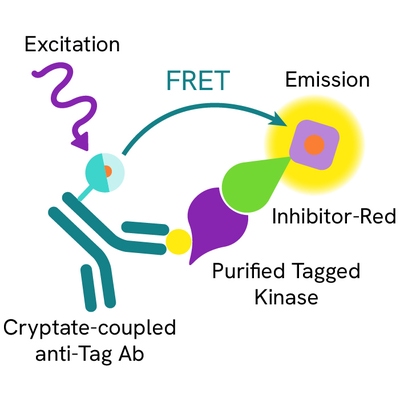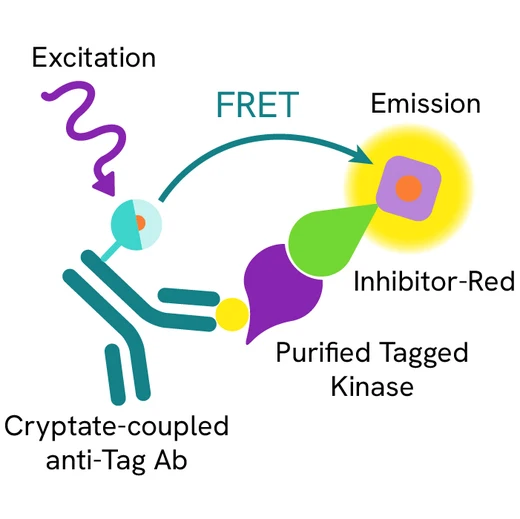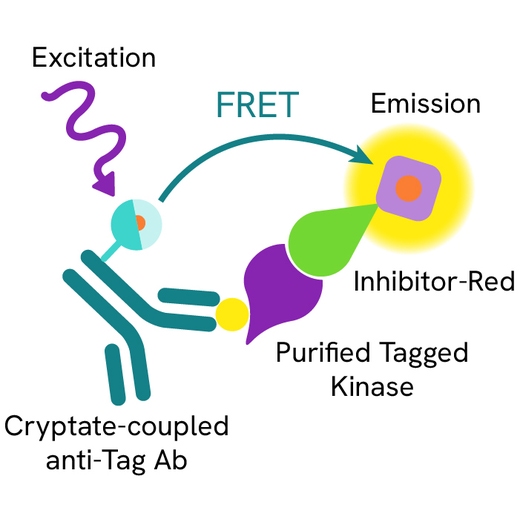

HTRF Kinase-6HIS Discovery Kit








| Feature | Specification |
|---|---|
| Application | Biochemical Enzymatic Assay |









Loading...
Product information
Overview
The best known kinase inhibitor, Gleevec (Imatinib), binds a non-activated form of Abl. Such inhibitors are therefore more difficult to detect using activity based assays, so it is worthwhile to set up kinase binding assays for your kinase of interest in order to avoid missing out on such compounds.
Moreover the HTRF® kinase binding assays are easily set up, using a mix and measure detection format in the absence of ATP.
Direct displacement of the fluorescent-inhibitor from the ATP binding pocket is measured, enabling the determination of the affinity of your inhibitor by performing dose response curves.
Purified kinase preparation is less critical compared to enzymatic assays, since measurements can be performed on kinases which have little or no activity.
How it works
Kinase-6HIS discovery kit assay principle
The binding of the tracers is detected in a sandwich assay format using a specific Anti 6HIS antibody labeled with Europium Cryptate (donor), which binds to 6HIS-tagged Kinase, and a red fluorescent tracer labelled with d2 (acceptor). The HTRF ratio (665/620) will increase upon the addition of more of the tracer, and will saturate depending on the dissociation constant (Kd) of the tracer to the 6HIS-tagged kinase. The Kinase-6HIS binding Discovery Kit helps determine which tracer might be best suited to setting up a binding assay. The tracer with the best assay properties (depending on the Kd and assay window generated) will be chosen to perform competitive binding assays.

Kinase-6HIS discovery kit assay protocol
Saturation binding experiments on the three tracers (i.e. Staurosporine-Red, Dasatinib-Red, and Sunitinib-Red) can be run in 96- or 384-well plates (20 µL final volume). First, a dilution series of tracer ranging between 0 and 1 µM in the Kinase Binding Buffer is prepared in a 96-well non-binding plate. Next, 5 µL of Kinase Binding Buffer are dispensed into the final 96- or 384-well plate. Then 5 µL of 6HIS tagged-Kinase are added, followed by 5 µL of Anti-6HIS Eu-cryptate. Finally, 5 µL of the red tracer solution are added. The HTRF ratio is measured after 1 H of incubation.

Assay validation
Saturation Binding FGFR1-6HIS
A typical saturation binding experiment is performed using final tracer concentrations between 0 and 250 nM, and measuring total- and non-specific binding signals. Subtracting the non-specific from the total binding signal gives the specific signal, which can be analysed to give the Kd. Here an example is shown where the best tracer for inhibitor studies proved to be Staurosporine-Red, with a Kd of 22 nM on 5 nM FGFR1-6HIS.

Saturation Binding PDGFRb-6HIS
A typical saturation binding experiment is performed using final tracer concentrations between 0 and 250 nM, and measuring total- and non-specific binding signals. Subtracting the non-specific from the total binding signal gives the specific signal, which can be analysed to give the Kd. Here an example is shown where the best tracer for inhibitor studies proved to be Sunitinib-Red, with a Kd of 45 nM on 5 nM PDGFRb-6HIS.

Specifications
| Application |
Biochemical Enzymatic Assay
|
|---|---|
| Brand |
HTRF
|
| Detection Modality |
HTRF
|
| Product Group |
Kit
|
| Shipping Conditions |
Shipped in Dry Ice
|
| Target Class |
Kinases
|
| Target Species |
Human
|
| Technology |
TR-FRET
|
| Therapeutic Area |
Metabolism/Diabetes
Neuroscience
Oncology & Inflammation
|
| Unit Size |
1 unit
|
Video gallery
Resources
Are you looking for resources, click on the resource type to explore further.
This guide provides you an overview of HTRF applications in several therapeutic areas.


How can we help you?
We are here to answer your questions.






























